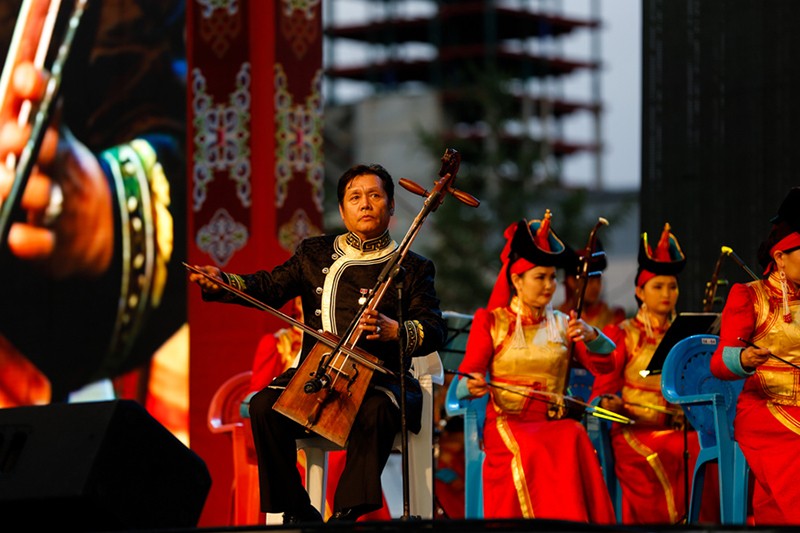
Mongolian nomads have long inhabited the Central Asian steppe. Among other names we proudly call ourselves, ‘nomadic Mongolians’ is quite popular and widely accepted. We have been living and moving around the vast steppe and rich territory at the heart of Asia for numerous millennia. At the same time, the music of nomads is as ancient as the nomadic way of living which translates as looking after herds of five different animals and changing pastures each season. Therefore, Mongolian ethnic music can be defined as nomads’ music.
If one wants to understand nomads’ music, it’s ideal for him/her to understand the essence of nomadic culture. Mongolian nomads lived in harmony with nature, were and are ever-dependent upon nature and ultimately worship it. It is said that Mongolian music including long song, khoomei (throat singing) and musical instruments were originally designated to imitate the sound of nature. Mongolian tales tell us the long song originated from human’s imitation of a wolf’s howl or alternatively in my wild guess, a horse’s neigh.
Mongolian long songs and khoomei usually praises nature, mountains, rivers, and so on. Also, nomads’ music is deeply connected to nomadic lifestyle itself. The most common and appealing beat in nomads’ music is the instrumental rendition of the sound of a galloping horse. Mongolian folk dances also closely relate to the customs of nomads displaying various behaviors and movements which all arose from the nomadic way of life.
 Basically, nomads’ musical heritage is original, exceptional and beautiful. Mongolian folk music is something you don’t hear in your daily lives. A number of Mongolian folk musicians and ethnic bands have performed and are performing around the world demonstrating the wonders of nomads’ music with warm and awed reception from audiences. For example, Mongolian long song singer G.Khongorzul sang at the 2005 Nobel Prize Concert and 2002 World Cup. Mongolian ethnic band ‘Khusugtun’ performed nomads’ music at BBC Proms 2011 Human Planet and the audience impression was just as it always is when people listen to Mongolian folk music for the first time.
Basically, nomads’ musical heritage is original, exceptional and beautiful. Mongolian folk music is something you don’t hear in your daily lives. A number of Mongolian folk musicians and ethnic bands have performed and are performing around the world demonstrating the wonders of nomads’ music with warm and awed reception from audiences. For example, Mongolian long song singer G.Khongorzul sang at the 2005 Nobel Prize Concert and 2002 World Cup. Mongolian ethnic band ‘Khusugtun’ performed nomads’ music at BBC Proms 2011 Human Planet and the audience impression was just as it always is when people listen to Mongolian folk music for the first time.
Now there’s a chance for you to feel the vibe of nomads if you stop by ‘Asar Urgoo (Tent Palace) of Legendary Nomads’ which has opened at the yard of the Choijin Lama Monastery-Museum in Ulaanbaatar. You can catch a live performances of Mongolian ethnic-ballad band ‘Altai’, named after the Altai Mountains located in Western Mongolia, and ancient Altai harp performance by famous harp player Ch.Munkh-Erdene.
You can also see Mongolian Toirom (Circle) dance which has lately been restored by Mongolian Ethnic Music Bureau headed by music expert N.Ganpurev. The dance has been mentioned in the Secret History of the Mongols, indicating its popularity in the 12-13th centuries. The concert is being played twice a day until October 15, and costs Tgs 25,000.
Kh.Aminaa

Mongolian nomads have long inhabited the Central Asian steppe. Among other names we proudly call ourselves, ‘nomadic Mongolians’ is quite popular and widely accepted. We have been living and moving around the vast steppe and rich territory at the heart of Asia for numerous millennia. At the same time, the music of nomads is as ancient as the nomadic way of living which translates as looking after herds of five different animals and changing pastures each season. Therefore, Mongolian ethnic music can be defined as nomads’ music.
If one wants to understand nomads’ music, it’s ideal for him/her to understand the essence of nomadic culture. Mongolian nomads lived in harmony with nature, were and are ever-dependent upon nature and ultimately worship it. It is said that Mongolian music including long song, khoomei (throat singing) and musical instruments were originally designated to imitate the sound of nature. Mongolian tales tell us the long song originated from human’s imitation of a wolf’s howl or alternatively in my wild guess, a horse’s neigh.
Mongolian long songs and khoomei usually praises nature, mountains, rivers, and so on. Also, nomads’ music is deeply connected to nomadic lifestyle itself. The most common and appealing beat in nomads’ music is the instrumental rendition of the sound of a galloping horse. Mongolian folk dances also closely relate to the customs of nomads displaying various behaviors and movements which all arose from the nomadic way of life.
 Basically, nomads’ musical heritage is original, exceptional and beautiful. Mongolian folk music is something you don’t hear in your daily lives. A number of Mongolian folk musicians and ethnic bands have performed and are performing around the world demonstrating the wonders of nomads’ music with warm and awed reception from audiences. For example, Mongolian long song singer G.Khongorzul sang at the 2005 Nobel Prize Concert and 2002 World Cup. Mongolian ethnic band ‘Khusugtun’ performed nomads’ music at BBC Proms 2011 Human Planet and the audience impression was just as it always is when people listen to Mongolian folk music for the first time.
Basically, nomads’ musical heritage is original, exceptional and beautiful. Mongolian folk music is something you don’t hear in your daily lives. A number of Mongolian folk musicians and ethnic bands have performed and are performing around the world demonstrating the wonders of nomads’ music with warm and awed reception from audiences. For example, Mongolian long song singer G.Khongorzul sang at the 2005 Nobel Prize Concert and 2002 World Cup. Mongolian ethnic band ‘Khusugtun’ performed nomads’ music at BBC Proms 2011 Human Planet and the audience impression was just as it always is when people listen to Mongolian folk music for the first time.
Now there’s a chance for you to feel the vibe of nomads if you stop by ‘Asar Urgoo (Tent Palace) of Legendary Nomads’ which has opened at the yard of the Choijin Lama Monastery-Museum in Ulaanbaatar. You can catch a live performances of Mongolian ethnic-ballad band ‘Altai’, named after the Altai Mountains located in Western Mongolia, and ancient Altai harp performance by famous harp player Ch.Munkh-Erdene.
You can also see Mongolian Toirom (Circle) dance which has lately been restored by Mongolian Ethnic Music Bureau headed by music expert N.Ganpurev. The dance has been mentioned in the Secret History of the Mongols, indicating its popularity in the 12-13th centuries. The concert is being played twice a day until October 15, and costs Tgs 25,000.
Kh.Aminaa
